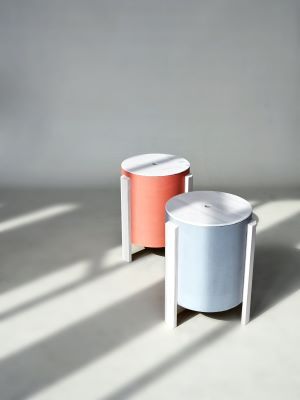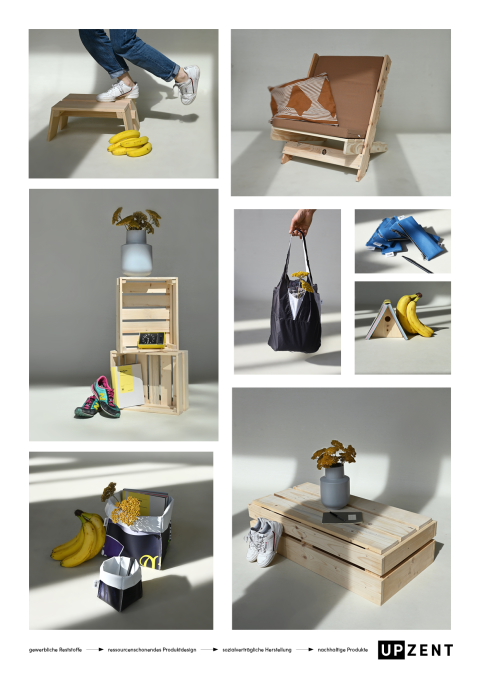In UpZent the approach of the Upcycling Centre is transferred into a transferable business model and tested at several locations. Suitable forms of organisation are being investigated for this purpose. The aim is to work out a business model for a resource-efficient circular economy around the topic of upcycling in order to establish a socio-economically sustainable structure. The production of upcycling products and the sensitisation of interested stakeholders are to contribute to a resource-efficient circular economy.

Circularity at regional level
The project leader, the Institute for Applied Material Flow Management (IfaS), has been operating an upcycling centre since 2016. UpZent is a project for circular economy, qualification and integration, which is being implemented in the district of Neunkirchen (Saarland) and in Herzogenrath. In the project, furniture and products are developed by product designers of K8 gGmbH and produced by a social company as part of qualification measures. In the sense of a resource-efficient circular economy, the aim is to establish a sustainable cascade through the conversion and upgrading of commercial waste materials at regional level on a permanent basis and in dialogue with companies, recyclers and consumers.
Economic model
Upcycling implies cycle-oriented and intelligent product designs, choice of raw materials, and production and reuse processes. This in turn requires trans-sectoral cooperation between different actors along the entire product life cycle, from product design and manufacture to use and recycling. The concept of the Upcycling Centre, which has already been developed and tested by IfaS, is based on a sustainable education strategy of the participants and supports their networking. The further development of the Upcycling Centre into a self-supporting business model enables transferability to other regions and can promote the system change towards a circular economy in Germany.
Research questions that are being addressed in this project are:
- Is it possible to jointly use economies of scale and standardisation so that a model can be organised in an economically viable manner?
- Is it possible to influence product design, production or the reuse of materials via an upcycling centre?
- What contribution can this instrument make in terms of the EU objective and taking into account the waste hierarchy in regional as well as decentralised structures?

Results (Status June 2022)
In the course of the project, the partners have continuously developed the circular product design, the manufacturing process and the product quality and security. Several working meetings for the further development of the product catalogue, product conferences, the standardization of the UPZENT procedures and coordination of product marketing were carried out.
In cooperation with the partners, residual materials were prepared and processed into new upcycling prototypes and products. UPZENT has currently around 15 products in the marketing, around 10 prototypes are currently being developed and another five products have undergone a redesign process. Since the start of the project, more than 2,500 products made from different residual materials such as wood, cardboard or textiles have been made by the social manufacture centers: AQA gGmbH in Neunkirchen and FAUK e. V. in Herzogenrath.
Nearly 30 partnerships were settled with local companies in the regional areas of the UPZENT manufacturing centers in Neunkirchen and Herzogenrath. Aim of the cooperation is the cascading use of residual materials and raising the awareness of the partner companies in recycling of the residual materials produced in their company and for more resource efficiency. UPZENT also raises awareness of sustainable consumption. The residues that could be acquired through the cooperation were inventoried in the form of a residue library and stored for further cooperation possibilities and product design purposes.
Different activities were carried out as part of the development of the UPZENT business and organizational model. In particular, the state of art on circular business models was researched in detail, a methodology for the development of the circular economy business model was defined and the organizational models of existing upcycling companies were analyzed. The UPZENT business model considering social, economic and ecological aspects were developed in cooperation with the project partners. These developments were initially grounded on the conventional Business Model Canvas. Based on this model, the Social Business Model Canvas was integrated and later the Circular Model Canvas and the European Social Economy Canvas were developed and integrated. This is how a new business model canvas was created, adapted to the activities and business model of UPZENT, which also takes social and ecological aspects into account. This model also enabled new innovative approaches that had not been considered before. The developed business model and the results of the canvas were observed and evaluated using a SWOT analysis.
Based on the previous results, the processes of UPZENT were analyzed and the most important project-related processes were defined. The aim of defining the process chain was to standardize the work processes and to clarify the respective responsibilities. The most important identified UPZENT processes include: material flow and residual materials analysis, product development and design, workshop licensing, order processing and manufacturing.
Regarding the sustainability assessment of UPZENT, three categories were defined. First, a qualitative analysis based on selected UN Sustainable Development Goals (SDGs) to identify the effects of UPZENT on sustainability, circularity and the circular economy. Secondly, a qualitative and quantitative analysis of the social, economic and ecological performance indicators of the UPZENT activities in the project period was developed. Finally, five most representative UPZENT products like GÜNTHER bank, VOLKER stool, HARALD chair, THIN NGOC kite bag and ILONA pencil case were examined; with the aim of making a comparison between the upcycling approach and the conventional recycling of the residual materials, which usually takes the form of thermal recycling and/or incineration.
The word mark UPZENT has been registered at the German Patent and Trade Mark Office (DPMA) since the beginning of 2022. The UPZENT trademark is basically intended to identify UPZENT products and services and was therefore registered for certain goods and services.
Thanks to the cooperation of all project partners, several networking activities could be carried out. In the course of the three project years, around 450,000 people were reached through newspaper articles; around 110,000 people through film contributions and around 1,000 people through lectures, project presentations, product exhibitions, networking meetings and awareness-raising measures.
Project team from research and companies
The project pursues an inter- and transdisciplinary research approach with high practical relevance. Therefore, in addition to the two university partners, the Trier University of Applied Sciences and the Saar University of Fine Arts, three upcycling centers are to be integrated as practice models and research platforms. Furthermore, the manufacturing industry and the waste management sector will be integrated.
In order to ensure that the project is processed efficiently and effectively, the upcycling centre already established in Neunkirchen and its corporate partners will act as a best practice model. The second project partner is also a non-profit organisation in the Aachen region, which has been planning to establish an upcycling centre for some time. The third location will be found during the project period.
The project team aims to develop the success factors for transferability. Essentially, these are suitable instruments and standardisation as well as the selection and design of a long-term sustainable business model and its configuration.
The research results thus enable interested parties to implement innovative and economically viable product cycles or cascade systems and to organize themselves within a network in such a way that economies of scale and synergies can be tapped.
Publications
Project flyer of the funding measure (German / English) (March 2021)
The project flyers offer an insight into the contents and goals of the ReziProK projects and present first results in each case.
Project sheets of the funding measure (German) (October 2019)
The project sheets provide a brief overview of the individual projects and their goals.
Contributions to the ReziProK Transfer Conference in June 2022
Poster (German) (June 2022)
Presentation (German) (June 2022)
Contributions to the ReziProK Kick-off event in December 2019
Poster - in German (December 2019)
Presentation - in German (December 2019)
Picture credits: Hochschule Trier, IfaS – Institut für angewandtes Stoffstrommanagement, UpZent, 2021
